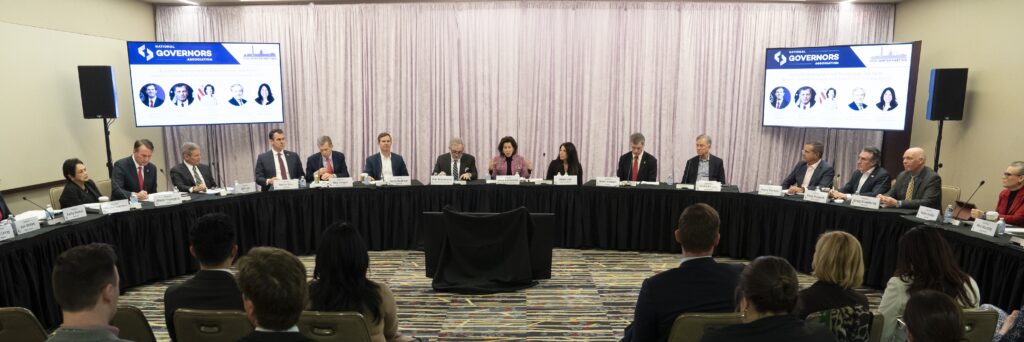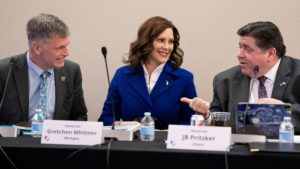At NGA’s Winter Meeting, Kentucky Governor Andy Beshear and South Carolina Governor Henry McMaster – co-chairs of the Economic Development and Revitalization Task Force – led a discussion on Governors’ Leadership in Technology and Energy Innovation.
Building off recently enacted federal legislation – such as the Infrastructure Investment and Jobs Act (IIJA), the CHIPS and Science Act (CHIPS), and the Inflation Reduction Act (IRA) – Governors are at a historic crossroads to propel American competitiveness by providing solutions to challenges in energy production and transmission, climate, mobility, and semiconductor manufacturing.
Along with federal and private sector partners, Governors are leading efforts to advance bipartisan priorities on renewable energy, grid modernization, technology innovation (from chip fabrication plants to electric vehicles and their charging infrastructure), reshoring, and supply chains.
Federal and private sector partners joining the discussion included:
- Alejandra Y. Castillo, Assistant Secretary of Commerce for Economic Development, U.S. Department of Commerce
- Maria Robinson, Director, Grid Deployment Office, U.S. Department of Energy
- Amy B. Spiller, State President, Ohio and Kentucky, Duke Energy
- Aamir Paul, President, North America Operations, Schneider Electric

Governor Beshear opened the discussion by noting that state economies haven’t just come back from the pandemic; they are “booming” – with Kentucky building “not one but three battery plants to power the next generation of automobiles.”
“That’s what we are able to do when the private sector and the public sector come together,” Governor Beshear explained. “And of course, what it means is jobs – good jobs. For somebody like me, the dad of a 12- and a 13-year-old, it means the best opportunity in my lifetime that no matter how big they dream, they can chase those dreams close to home.”
Noting that South Carolina is the nation’s third largest producer of nuclear energy and home to multiple battery plants and solar farms, Governor McMaster commented, “We’re at a real crossroads and everything depends on energy, so we need plenty of it. We all have the opportunity to be on the cutting edge.”
Alejandra Y. Castillo, Assistant Secretary of Commerce for Economic Development, kicked off the panel by summarizing the economic development programs administered through the U.S. Department of Commerce.
“It’s not about just looking back and making sure that our country is coming out of this pandemic,” Castillo commented. “But really looking forward and reimagining, not just our current economy, but also the future economy and making sure along the way that we have the right ingredients and prepare our ecosystems to be able to sustain the results of the current funding.”
Castillo shared updates on a number of Commerce Department initiatives funded by IIJA, IRA, CHIPS, and the American Rescue Plan Act (ARPA) – including $42.5 billion for the Broadband Equity Access and Deployment (BEAD) program; funding to enhance the National Oceanic and Atmospheric Administration’s (NOAA) data collection capability in tracking severe weather; $500 million through the Economic Development Administration (EDA) to support Tech Hubs and $200 million for the RECOMPETE program. Castillo noted that all 55 states and territories had received ARPA funding through EDA. She invited Governors and mayors to work together to form coalitions that can respond to the forthcoming Tech Hubs and RECOMPETE funding.
Castillo also highlighted $58 billion in CHIPS funding to bring back the semiconductor industry to the U.S., which she characterized as “not just an economic priority but also a national security imperative.”
Maria Robinson, Director of the Grid Deployment Office with the U.S. Department of Energy, shared the department’s perspective on the recent funding packages and upcoming funding. “The way the grid is set up does not follow the way that states are set up,” she noted. “Working together across state borders and across regional borders is so important to ensure that we’re maximizing investment through these different pieces of legislation.”
Robinson highlighted the latest Energy Department investment opportunities funded through the specified legislation, including: the domestic manufacturing of battery plants; developing new hydrogen hubs; expanding electric vehicle charging infrastructure; securing a strong supply chain for energy technologies; catalyzing the nationwide development of new and upgraded, high capacity, electric transmission lines; and supporting investments to modernize the overall flexibility and resilience of the distribution system.
Both Castillo and Robinson emphasized that application opportunities and funding announcements remain ongoing. They welcomed Governors and their staff to work with the Commerce and Energy departments, and visit their websites, to ensure states take advantage of opportunities.
Turning to the private sector, Duke Energy’s Amy Spiller provided an update on how her company is pursuing opportunities enabled by recent legislation. Duke Energy, which serves 9.8 million electric and natural gas customers across seven states, is working toward its goal to achieve net zero carbon emissions by 2050. To that end, Duke Energy, in coordination with state and local partners, is pursuing funding opportunities and tax credits (including credits related to solar production, battery and pumped hydropower storage, and nuclear production) under IIJA and IRA to make that transition while mitigating costs to customers.
One example Spiller cited of a public-private partnership across states is the southeast hydrogen hub. Launched in coordination with states and a variety of utility companies, the coalition aims to develop an infrastructure network of projects across the six states (Alabama, Georgia, Kentucky, North Carolina, South Carolina and Tennessee) to form the basis for hydrogen infrastructure expected to generate significant job growth and economic development. “Businesses in [these states] have their own climate goals, and they are depending upon us at Duke Energy to help them be successful in achieving those goals,” Spiller commented. “We have seen that access to cleaner, affordable, reliable power is indeed a very effective economic development tool.”
Schneider Electric, which employs 2,000 people in three factories in Kentucky and South Carolina, is poised to harness the current policy environment to increase its investments. Aamir Paul shared that Schneider has tripled its capital investments in U.S.-based manufacturing since 2020, in response to the supply chain crisis – shifting from a “just-in-time to a just-in-case” model. Under new Biden administration policies, Schneider plans to increase its investments to a level cumulatively five times greater than its pre-pandemic investments. Paul shared several examples of these capital investments, including a project to electrify JFK Airport, and public-private partnership to build a 6.5 megawatt bus depot in Montgomery County, Maryland. The project will power 70 fully electric buses and support a micro grid that can power local homes in emergency situations.
Paul emphasized the importance of his company’s focus on digital transformation and the job opportunities it can generate. “We are looking at digital transformation in a very big way,” he stated. “Our guidance to our customers, and therefore everyone in this room, is we have to digitize, decarbonize, and engage… I think is really important is to make sure that we continue job training. We will need millions of energy professionals – from PV to electricians to EV maintenance to field technicians to the people working in our water and port infrastructure. As communities digitize more, this is an incredible opportunity to create both technology but also human capital.”

During a question-and-answer session, Oklahoma Governor Kevin Stitt opened the robust discussion by asking panelists about their thoughts on the future of small, modular, nuclear power plants. Wyoming Governor Mark Gordon followed up with a question about building out a domestic supply of uranium and panelist’s perspective on micro-grids. Maryland Governor Wes Moore asked how we can avoid perpetuating existing inequities as we build out new energy production and distribution. Delaware Governor John Carney pivoted to a discussion on how electric vehicles can be best integrated into the grid. Puerto Rico Governor Pedro Pierluisi gave an update on progress of post-hurricane reconstruction in Puerto Rico. Washington Governor Jay Inslee brought the conversation back to ensuring a secure supply change for the materials needed for the energy transition, and Maine Governor Janet Mills closed the discussion by inquiring on federal alignment with state plans on large scale projects, particularly off-shore wind.
Wrapping up the panel discussion, Governor Beshear expressed appreciation for the spirit of bipartisan cooperation evident at NGA’s Winter Meeting, “There is a great feeling at this conference this year,” he commented. “We’ve had real discussions. We have done it civilly. Everybody [is] trying to do their best for the people of their state, and I want to thank all of our other Governors for being able to come together this way and show the country how it can be done.”












